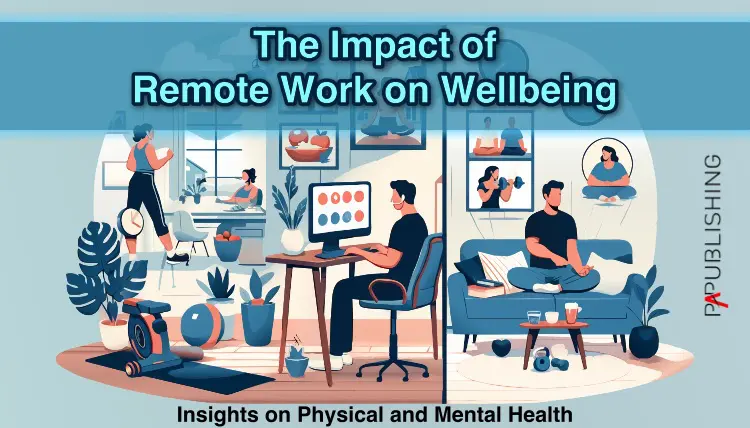Remote Work on Wellbeing: In past years, remote work has become increasingly prevalent, driven by technological advances and necessitated by global events. This shift from traditional office settings to home offices affects the physical and mental health of employees in various ways. While working from home offers several advantages, it also presents unique challenges that can impact overall wellbeing. This article delves into the multifaceted effects of remote work on both physical and mental health, productivity, work-life balance, and provides best practices for maintaining health and wellbeing while working remotely.
What Are the Effects of Remote Work on Wellbeing?
How does working from home affect physical health?
Remote Work on Wellbeing: Remote work significantly impacts physical health, as the nature of home offices and work at home arrangements can sometimes lead to a sedentary lifestyle. Common health effects include back, neck, and eye strain due to prolonged screen time and poor ergonomic setups. These factors contribute to physical health challenges that may result in chronic pain if not addressed properly. Moreover, the absence of a daily commute and the lack of physical movement typically incorporated in traditional job settings can exacerbate these issues, impacting overall physical wellbeing.

What are the mental health implications of remote work?
While remote work offers flexibility, it also blurs the lines between work and personal life, potentially leading to mental health issues such as stress, anxiety, and depression. Employees who work remotely may experience social isolation, reduced job satisfaction, and a sense of disconnection from their teams. The continuous work hours and the inability to delineate work time from personal time can contribute to burnout. These mental health implications highlight the importance of strategies to maintain psychological well-being in a remote work environment.
Can working remotely improve overall wellbeing?
Despite the potential negative impact, remote work can also improve overall well-being. Many employees report a better work-life balance and increased productivity due to the flexibility and autonomy that home working provides. Eliminating the daily commute can free up time for physical activities and hobbies, fostering a healthier lifestyle. Additionally, a well-structured remote work schedule that includes regular breaks and physical activity can enhance both physical and mental health, offering a more balanced approach to work and personal life.

How Does Remote Work Influence Productivity?
Can productivity increase when you work from home?
Working from home may boost productivity for many individuals, as the flexibility to create a personalized work environment can lead to more efficient and focused work. Remote workers can concentrate better and manage their tasks without the distractions often present in traditional office settings. This newfound efficiency can improve job satisfaction and overall performance, demonstrating one of the significant positive effects of remote work on productivity.
What are the common productivity challenges faced while working remotely?
Remote Work on Wellbeing: Despite the potential for increased productivity, remote work isn’t without its challenges. Common obstacles include distractions at home, difficulty in managing work hours, and a lack of face-to-face interaction, which can lead to miscommunication and decreased collaboration. Additionally, the absence of a structured work schedule may lead to longer working hours and reduced downtime, negatively impacting both productivity and health. These challenges necessitate the implementation of effective strategies to maintain productivity while working remotely.
How can home office setups impact productivity?
The setup of a home office plays a crucial role in determining productivity levels for remote workers. A well-designed work environment with ergonomic furniture, adequate lighting, and minimal distractions can significantly enhance productivity. Conversely, a poorly arranged home office can lead to discomfort, frequent interruptions, and reduced efficiency. Investing in a conducive workspace is essential for remote employees to work effectively and maintain high productivity levels.
What Are the Benefits and Challenges of Working From Home?
What are the key benefits of working from home?
The benefits of working from home are increased flexibility, autonomy, and the ability to create a comfortable and personalized work environment. Employees who work remotely often report higher job satisfaction due to the freedom to manage their work schedule around personal commitments. Additionally, eliminating commuting time allows for more leisure activities and family time, contributing to improved work-life balance and overall well-being.
What challenges do employees face when they work remotely?
While home working offers numerous benefits, it also presents challenges such as isolation, blurred work-life boundaries, and the potential for a sedentary lifestyle. Remote workers may struggle with maintaining professional relationships and effective communication, impacting teamwork and productivity. The lack of a structured daily routine can also lead to procrastination and difficulty in managing work time, highlighting the importance of discipline and time management skills in a remote work setup.
How can companies support remote workers for better productivity?
Remote Work on Wellbeing: To help remote workers succeed, companies can offer various forms of support, such as providing the necessary tools and resources for a functional home office and ensuring regular virtual check-ins to maintain communication and collaboration. Encouraging flexible work schedules, promoting mental health resources, and offering training on time management can also greatly enhance productivity. By supporting their remote workforce, companies can foster a positive and productive work environment that benefits both employees and the organization.
How Does Remote Work Affect Work-Life Balance?
Can home working offer a better work-life balance?
Remote Work on Wellbeing: Home working can significantly improve work-life balance by allowing individuals to customize their work schedule and eliminate the daily commute. This flexibility enables employees to spend more time on personal interests, family, and self-care activities outside of work, enhancing their overall well-being. A well-managed remote work arrangement allows employees to allocate time efficiently between professional and personal responsibilities, achieving a better work-life balance.
What strategies can help maintain work-life balance while working from home?
Maintaining work-life balance while working remotely requires setting clear boundaries between work time and personal time. Establishing a designated workspace, adhering to a consistent work schedule, and taking regular breaks can help employees manage their time effectively. Engaging in leisure activities and exercise and ensuring time is set aside for relaxation and social interaction are also vital strategies for preserving work-life balance and enhancing overall well-being while working from home.
How does commute elimination impact work-life balance?
The elimination of the daily commute is one of the most significant positive effects of remote work on work-life balance. Without the need to travel to and from the office, employees save considerable time and reduce the stress associated with commuting. This extra time can be redirected towards personal activities, family time, or rest, contributing to a healthier and more balanced lifestyle. The reduced strain and increased availability for personal pursuits can improve physical and mental well-being.
What Are the Best Practices for Maintaining Wellbeing While Working Remotely?
How can one create a healthy work environment at home?
Creating a healthy work environment at home involves setting up a dedicated workspace that is free from distractions and equipped with ergonomic furniture. Proper lighting, ventilation, and a quiet atmosphere are important to enhance concentration and productivity. Additionally, maintaining a clean and organized work area can reduce stress and create a positive work environment. Employees should also establish a regular routine, including scheduled breaks and physical movement, to promote physical and mental well-being.
What are effective ways to maintain physical health while working from home?
Remote Work on Wellbeing: Maintaining physical health while working from home requires incorporating physical activity into the daily routine. This can include regular exercise, stretching, and short walks to counteract the sedentary nature of remote work. Ergonomic furniture and proper posture are essential to prevent musculoskeletal issues. Additionally, staying hydrated, eating nutritious meals, and ensuring adequate rest are vital components of a healthy lifestyle that supports overall physical wellbeing while working remotely.
What mental health practices are essential for remote workers?
Essential mental health practices for remote workers include setting boundaries between work and personal life to prevent burnout. Regular breaks, mindfulness exercises, and staying connected with colleagues through virtual interactions can help reduce feelings of isolation and stress. Seeking professional support when needed, engaging in hobbies, and maintaining a healthy work-life balance are crucial for sustaining mental wellbeing. Prioritizing mental health alongside professional responsibilities ensures a harmonious remote work experience.
Q: How does remote work affect health and well-being?
A: Remote work can impact health and well-being in various ways. While it offers flexibility and can reduce stress from commuting, it can also lead to isolation and sedentary behavior, affecting both mental and physical health. It’s important to find a balance to ensure overall employee well-being.
Q: What are the effects of working from home on physical well-being?
A: The effects of working from home on physical well-being can include both positive and negative outcomes. On the positive side, people who work from home can have more time to exercise and prepare healthy meals. However, working from home is often associated with reduced physical activity due to prolonged sitting and remote work arrangements without adequate ergonomic setups.
Q: How can companies support the mental and physical health of remote employees?
A: Remote Work on Wellbeing: Companies can support employee well-being by offering flexible work arrangements, providing resources for mental and physical health, and encouraging regular breaks and physical activity. Creating a supportive work culture and maintaining open communication are also key strategies.
Q: What are the challenges of managing mental and physical health while working from home?
A: Challenges include feelings of isolation, difficulty separating work tasks from personal life, and reduced physical activity. It is crucial for employees to establish boundaries, create a dedicated workspace, and prioritize self-care to manage these challenges effectively.
Q: Can working from home positively affect employee well-being?
A: Yes, working from home can positively affect employee well-being by offering greater work-life balance, reducing commuting time, and allowing for more flexible work options. These benefits can enhance job satisfaction and overall health, provided that employees maintain healthy habits.
Q: How does remote work influence weekly working hours?
A: Remote work can sometimes blur the boundaries between work and personal life, potentially leading to longer weekly working hours. It’s important for employees to set clear boundaries and establish a routine to prevent overworking and to safeguard their health and well-being.
Q: What are some strategies to maintain a healthy work-life balance while working from home?
A: Strategies include setting specific working hours, taking regular breaks, creating a dedicated workspace, and prioritizing physical activity and self-care. Communication with employers about workload and expectations is also crucial to maintaining a balance that supports health and well-being.
Q: How do flexible work arrangements benefit the working population?
A: Flexible work arrangements can cater to various needs of the working population, including those with caregiving responsibilities, health conditions, or a preference for non-traditional working hours. This flexibility can enhance overall employee well-being and productivity.
Q: What role does the National Bureau of Economic Research play in studying the effects of remote work?
A: Remote Work on Wellbeing: The National Bureau of Economic Research conducts studies to understand the impacts of remote work on various factors such as productivity, mental and physical health, and economic outcomes. Their research helps inform policy decisions and organizational practices to support the working population in the context of new work environments.
Q: How can employees ensure they are able to work from home effectively?
A: Employees can ensure they are able to work from home effectively by setting up a comfortable and ergonomic workspace, maintaining a regular schedule, staying connected with colleagues, and taking care of their mental and physical health through regular exercise and breaks.



